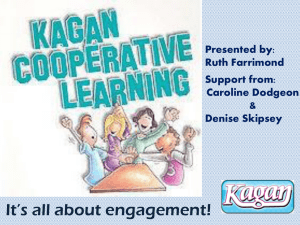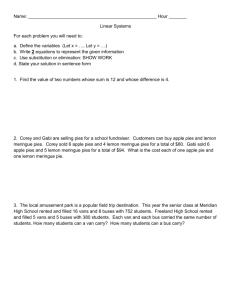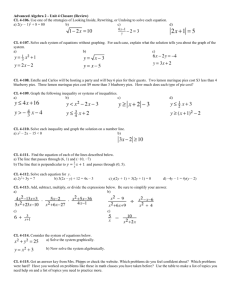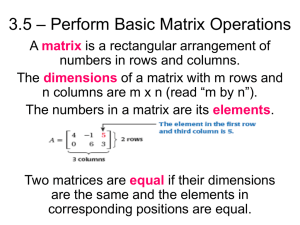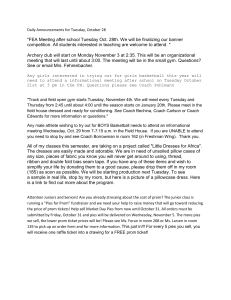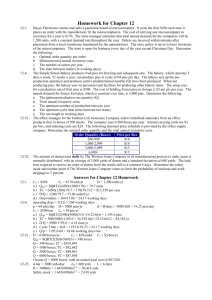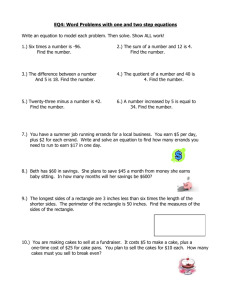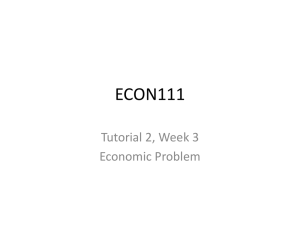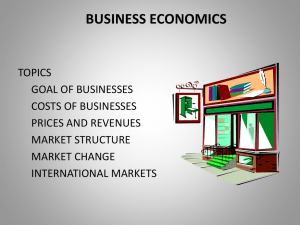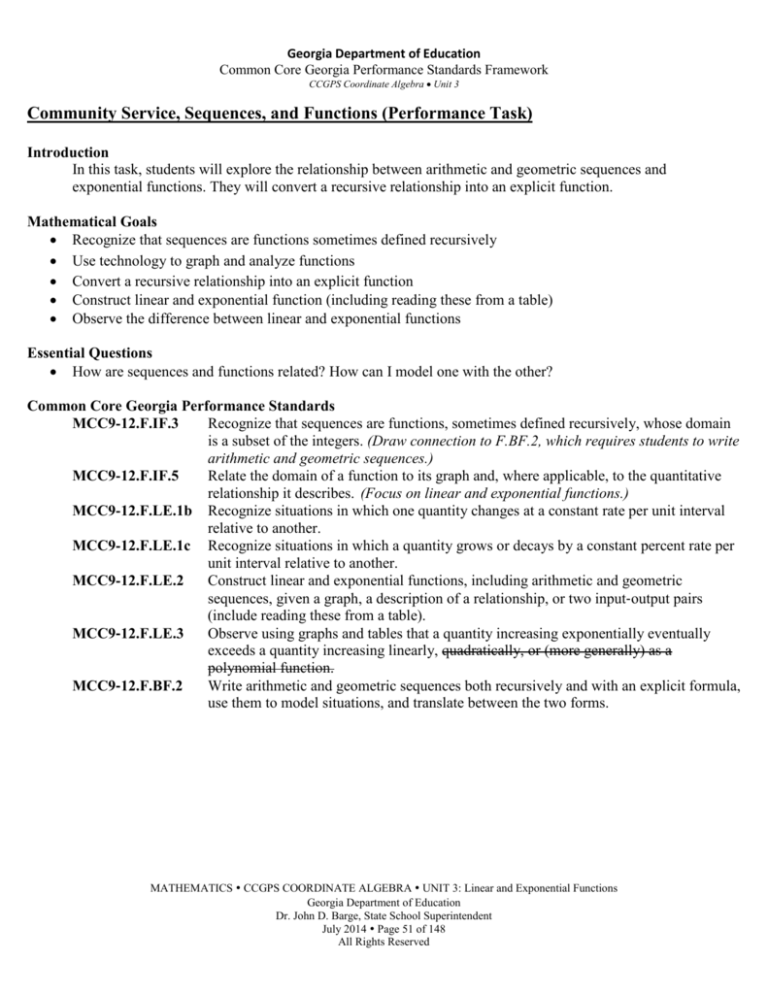
Georgia Department of Education
Common Core Georgia Performance Standards Framework
CCGPS Coordinate Algebra • Unit 3
Community Service, Sequences, and Functions (Performance Task)
Introduction
In this task, students will explore the relationship between arithmetic and geometric sequences and
exponential functions. They will convert a recursive relationship into an explicit function.
Mathematical Goals
• Recognize that sequences are functions sometimes defined recursively
• Use technology to graph and analyze functions
• Convert a recursive relationship into an explicit function
• Construct linear and exponential function (including reading these from a table)
• Observe the difference between linear and exponential functions
Essential Questions
• How are sequences and functions related? How can I model one with the other?
Common Core Georgia Performance Standards
MCC9‐12.F.IF.3
Recognize that sequences are functions, sometimes defined recursively, whose domain
is a subset of the integers. (Draw connection to F.BF.2, which requires students to write
arithmetic and geometric sequences.)
MCC9‐12.F.IF.5
Relate the domain of a function to its graph and, where applicable, to the quantitative
relationship it describes. (Focus on linear and exponential functions.)
MCC9‐12.F.LE.1b Recognize situations in which one quantity changes at a constant rate per unit interval
relative to another.
MCC9‐12.F.LE.1c Recognize situations in which a quantity grows or decays by a constant percent rate per
unit interval relative to another.
MCC9‐12.F.LE.2
Construct linear and exponential functions, including arithmetic and geometric
sequences, given a graph, a description of a relationship, or two input‐output pairs
(include reading these from a table).
MCC9‐12.F.LE.3
Observe using graphs and tables that a quantity increasing exponentially eventually
exceeds a quantity increasing linearly, quadratically, or (more generally) as a
polynomial function.
MCC9‐12.F.BF.2
Write arithmetic and geometric sequences both recursively and with an explicit formula,
use them to model situations, and translate between the two forms.
MATHEMATICS CCGPS COORDINATE ALGEBRA UNIT 3: Linear and Exponential Functions
Georgia Department of Education
Dr. John D. Barge, State School Superintendent
July 2014 Page 51 of 148
All Rights Reserved
Georgia Department of Education
Common Core Georgia Performance Standards Framework
CCGPS Coordinate Algebra • Unit 3
Standards for Mathematical Practice
4. Model with mathematics.
Students will create sequences from context and model them with tables and equations.
7. Look for and make use of structure.
Students will use tables to formulate equations.
8. Look for and express regularity in repeated reasoning.
Students will recognize patterns within sequences.
Background Knowledge
• Students understand sequences as functions.
• Students can use and write explicit and recursive formulas for sequences.
Common Misconceptions
• Students may confuse explicit and recursive formulas and the parts that make them up.
Materials
• None
Grouping
• Partner / Individual
Differentiation
Extension:
• Have students write explicit and recursive formulas for the amount of money collected.
a n = a n-1 + 5
#7: a n = 5n;
n-1
#8: a n = 5(2) ; a n = 2a n
Intervention:
• Provide students with two rows in the table
• Give formulas for the sequences.
Formative Assessment Questions
• How are sequences related to functions?
• What types of real-life situations can be modeled with functions?
MATHEMATICS CCGPS COORDINATE ALGEBRA UNIT 3: Linear and Exponential Functions
Georgia Department of Education
Dr. John D. Barge, State School Superintendent
July 2014 Page 52 of 148
All Rights Reserved
Georgia Department of Education
Common Core Georgia Performance Standards Framework
CCGPS Coordinate Algebra • Unit 3
Community Service, Sequences, and Functions – Teacher Notes
Comment:
Activities that require students to practice completing geometric and arithmetic sequences and generate an explicit
and recursive formula from those sequences should occur prior to completing this task.
Larry, Moe, and Curly spend their free time doing community service projects. They would like to
get more people involved. They began by observing the number of people who show up to the
town cleanup activities each day. The data from their observations is recorded in the given table
for the Great Four Day Cleanup.
x
1
2
3
4
y
5
27
49
71
1. Give a verbal description of what the domain and range presented in the table represents.
Solution:
The domain is the number of days. The range represents the number of people that showed up each day.
2. Sketch the data on the grid below.
3. Determine the type of function modeled in the graph above and describe key features of the graph.
Solution:
Answers may vary. The graph models a linear function. The sequence represents discrete data. Looking at
the graph, the pattern appears to be increasing at a constant rate of change.
4. Based on the pattern in the data collected, what recursive process could Larry, Curly, and Moe write?
Solution:
a 1 = 5, a n = a n-1 +22
5. Write a linear equation to model the function.
Solution:
Students could answer in the form of the explicit formula, a n = 5 + 22(n – 1), or in slope-intercept form f(x)
= 22x – 17. Students should understand the relationship between these two forms.
MATHEMATICS CCGPS COORDINATE ALGEBRA UNIT 3: Linear and Exponential Functions
Georgia Department of Education
Dr. John D. Barge, State School Superintendent
July 2014 Page 53 of 148
All Rights Reserved
Georgia Department of Education
Common Core Georgia Performance Standards Framework
CCGPS Coordinate Algebra • Unit 3
6. How would Larry, Curly, and Moe use the explicit formula to predict the number of people who would help if the
cleanup campaign went on for 7 days?
Solution:
By evaluating f(x) = 22x – 17 (or 𝒂𝒏 = 𝟓 + (𝒏 − 𝟏)𝟐𝟐 ) substituting 7 for the x value in the explicit
formula, they could predict that 22(7) –17 or 137 people will show up on day 7 if the cleanup campaign
continued.
Excited about the growing number of people participating in community service, Larry, Curly, and Moe decide to
have a fundraiser to plant flowers and trees in the parks that were cleaned during the Great Four Day cleanup. It will
cost them $5,000 to plant the trees and flowers. They decide to sell some of the delicious pies that Moe bakes with his
sisters. For every 100 pies sold, it costs Moe and his sisters $20.00 for supplies and ingredients to bake the pies.
Larry, Curly, and Moe decide to sell the pies for $5.00 each.
7. Complete the following table to find the total number of pies sold and the amount of money the trio collects.
a. On Day 1, each customer buys the same number of pies
as his customer number. In other words the first customer
buys 1 pie, the second customer buys 2 pies. Fill in the
table showing the number of pies and the amount
collected on Day 1. Then calculate the total number of
pies sold and dollars collected.
b. Write a recursive and explicit formula for the pies sold on
Day 1. Explain your thinking.
Customer
Number
1
2
3
4
5
6
7
8
9
10
total
Number of
Pies Sold
1
2
3
4
5
6
7
8
9
10
55
Amount
Collected
$5
$10
$15
$20
$25
$30
$35
$40
$45
$50
$275
Solution:
Since the number of pies sold to each customer is the same as the customer number, we have the explicit
formula that a n = n , where a n is the number of pies and n is the customer number. We can also notice that
the number of pies increases by one each time so a n = a n - 1 + 1, where a n is the number of pies, is the
recursive formula for the number of pies sold.
Extension:
To obtain the explicit formula for the amount collected, we can multiply the number of pies sold by 5. This
gives us a n = 5n, where a n is the cost of the pies sold and n is the customer number.
c. On Day 2, the first customer buys 1 pie, the second
customer buys 2 pies, the third customer buys 4 pies, the
fourth customer buys 8 pies, and so on. Complete table
based on the pattern established. Then calculate the total
Customer
Number
1
2
Number of
Pies Sold
1
2
MATHEMATICS CCGPS COORDINATE ALGEBRA UNIT 3: Linear and Exponential Functions
Georgia Department of Education
Dr. John D. Barge, State School Superintendent
July 2014 Page 54 of 148
All Rights Reserved
Amount
Collected
$5
$10
Georgia Department of Education
Common Core Georgia Performance Standards Framework
CCGPS Coordinate Algebra • Unit 3
number of pies sold and dollars collected.
d. Write a recursive and explicit formula for the pies sold on
Day 2. Explain your thinking.
3
4
5
6
7
8
9
10
total
4
8
16
32
64
128
256
512
1023
$20
$40
$80
$160
$320
$640
$1280
$2560
$5115
Solution:
Since the number of pies sold to each customer doubles each time, we have the explicit formula that a n =
2n-1, where a n is the number of pies and n is the customer number. We also have that the recursive formula
is a n = 2a n-1 , where a n is the number of pies.
Extension: To obtain the explicit formula for the amount collected, we can multiply the number of pies sold
by 5. This gives us a n = 5(2)n-1, where a n is the price of the pies and n is the customer number. Looking at
a recursive pattern, we notice that the price column still doubles each time. This gives a recursive formula
of a n = 2a n-1 for the price of pies, where a n is the cost of the pies.
8. Compare the rates of change on Day 1 and Day 2 for the number of pies sold.
Solution:
Answers may vary.
Possible answer:
When the change in x is 1, Day 1 (linear) the change in y is a constant (slope).
On day two, (exponential) the y-values are multiplied by a constant ratio to get the succeeding y-value.
9. Did Larry, Curly, and Moe earn enough in two days to fund their project? Consider costs incurred to bake the
pies. Justify your reasoning.
Solution:
There are two ways students might answer this question. a) Students assume that $20 per 100 pies is really
$0.20 per pie OR b)students assume that they must purchase pies in 100 pie increments.
Therefore…
On the first day, they sold 55 pies and made $275. a) At a cost of $20 per 100 pies, they spent $11 on
ingredients. This yields a profit of $264. OR b) They spent $20 on 100 pies, of which they sold 55. They
yield a profit $255.
On the second day, they sold 1023 pies and made $5115. a) At a cost of $20 per 100 pies, they spent $204.60
on ingredients. Their profit on day two was $4910.40. OR b) They spent $220 on 1100 pies, of which they
sold 1023 pies. They yield a profit of $4895.
Combining their profit from day 1 and day 2 yields a total of a) $5174.40 OR b) $5150. Therefore, the trio
reached their project goal of $5000.
MATHEMATICS CCGPS COORDINATE ALGEBRA UNIT 3: Linear and Exponential Functions
Georgia Department of Education
Dr. John D. Barge, State School Superintendent
July 2014 Page 55 of 148
All Rights Reserved
Georgia Department of Education
Common Core Georgia Performance Standards Framework
CCGPS Coordinate Algebra • Unit 3
Performance Task: Community Service, Sequences, and Functions
Name_________________________________
Date__________________
Mathematical Goals
• Recognize that sequences are functions sometimes defined recursively
• Use technology to graph and analyze functions
• Convert a recursive relationship into an explicit function
• Construct linear and exponential function (including reading these from a table)
• Observe the difference between linear and exponential functions
Essential Questions
• How are sequences and functions related? How can I model one with the other?
Common Core Georgia Performance Standards
MCC9‐12.F.IF.3
Recognize that sequences are functions, sometimes defined recursively, whose domain
is a subset of the integers. (Draw connection to F.BF.2, which requires students to write
arithmetic and gemetric sequences.)
MCC9‐12.F.IF.5
Relate the domain of a function to its graph and, where applicable, to the quantitative
relationship it describes. (Focus on linear and exponential functions.)
MCC9‐12.F.LE.1b Recognize situations in which one quantity changes at a constant rate per unit interval
relative to another.
MCC9‐12.F.LE.1c Recognize situations in which a quantity grows or decays by a constant percent rate per
unit interval relative to another.
MCC9‐12.F.LE.2
Construct linear and exponential functions, including arithmetic and geometric
sequences, given a graph, a description of a relationship, or two input‐output pairs
(include reading these from a table).
MCC9‐12.F.LE.3
Observe using graphs and tables that a quantity increasing exponentially eventually
exceeds a quantity increasing linearly, quadratically, or (more generally) as a
polynomial function.
MCC9‐12.F.BF.2
Write arithmetic and geometric sequences both recursively and with an explicit formula,
use them to model situations, and translate between the two forms.
Standards for Mathematical Practice
4. Model with mathematics.
7. Look for and make use of structure.
8. Look for and express regularity in repeated reasoning.
MATHEMATICS CCGPS COORDINATE ALGEBRA UNIT 3: Linear and Exponential Functions
Georgia Department of Education
Dr. John D. Barge, State School Superintendent
July 2014 Page 56 of 148
All Rights Reserved
Georgia Department of Education
Common Core Georgia Performance Standards Framework
CCGPS Coordinate Algebra • Unit 3
Performance Task: Community Service, Sequences, and Functions
Name_________________________________
Date__________________
Larry, Moe, and Curly spend their free time doing community service projects. They would like to
get more people involved. They began by observing the number of people who show up to the
town cleanup activities each day. The data from their observations is recorded in the given table
for the Great Four Day Cleanup.
1.
Give a verbal description of what the domain and range presented in the table represents.
2.
Sketch the data on the grid below.
x
1
2
3
4
y
5
27
49
71
3. Determine the type of function modeled in the graph above and describe key features of the graph.
4. Based on the pattern in the data collected, what recursive process could Larry, Curly, and Moe write?
5. Write a linear equation to model the function.
6. How would Larry, Curly, and Moe use the explicit formula to predict the number of people who would help if the
cleanup campaign went on for 7 days?
MATHEMATICS CCGPS COORDINATE ALGEBRA UNIT 3: Linear and Exponential Functions
Georgia Department of Education
Dr. John D. Barge, State School Superintendent
July 2014 Page 57 of 148
All Rights Reserved
Georgia Department of Education
Common Core Georgia Performance Standards Framework
CCGPS Coordinate Algebra • Unit 3
Excited about the growing number of people participating in community service, Larry, Curly, and Moe decide to
have a fundraiser to plant flowers and trees in the parks that were cleaned during the Great Four Day cleanup. It will
cost them $5,000 to plant the trees and flowers. They decide to sell some of the delicious pies that Moe bakes with his
sisters. For every 100 pies sold, it costs Moe and his sisters $20.00 for supplies and ingredients to bake the pies.
Larry, Curly, and Moe decide to sell the pies for $5.00 each.
7. Complete the following table to find the total number of pies sold and the amount of money the trio collects.
a. On Day 1, each customer buys the same number of pies
as his customer number. In other words the first customer
buys 1 pie, the second customer buys 2 pies. Fill in the
table showing the number of pies and the amount
collected on Day 1. Then calculate the total number of
pies sold and dollars collected.
Customer
Number
1
2
Number of
Pies Sold
1
2
Amount
Collected
$5
$10
Number of
Pies Sold
1
2
Amount
Collected
$5
$10
b. Write a recursive and explicit formula for the pies sold on
Day 1. Explain your thinking.
total
c. On Day 2, the first customer buys 1 pie, the second
customer buys 2 pies, the third customer buys 4 pies, the
fourth customer buys 8 pies, and so on. Complete table
based on the pattern established. Then calculate the total
number of pies sold and dollars collected.
Customer
Number
1
2
d. Write a recursive and explicit formula for the pies sold on
Day 2. Explain your thinking.
total
MATHEMATICS CCGPS COORDINATE ALGEBRA UNIT 3: Linear and Exponential Functions
Georgia Department of Education
Dr. John D. Barge, State School Superintendent
July 2014 Page 58 of 148
All Rights Reserved
Georgia Department of Education
Common Core Georgia Performance Standards Framework
CCGPS Coordinate Algebra • Unit 3
8. Compare the rates of change on Day 1 and Day 2 for the number of pies sold.
9. Did Larry, Curly, and Moe earn enough in two days to fund their project? Consider costs incurred to bake the
pies. Justify your reasoning.
MATHEMATICS CCGPS COORDINATE ALGEBRA UNIT 3: Linear and Exponential Functions
Georgia Department of Education
Dr. John D. Barge, State School Superintendent
July 2014 Page 59 of 148
All Rights Reserved

